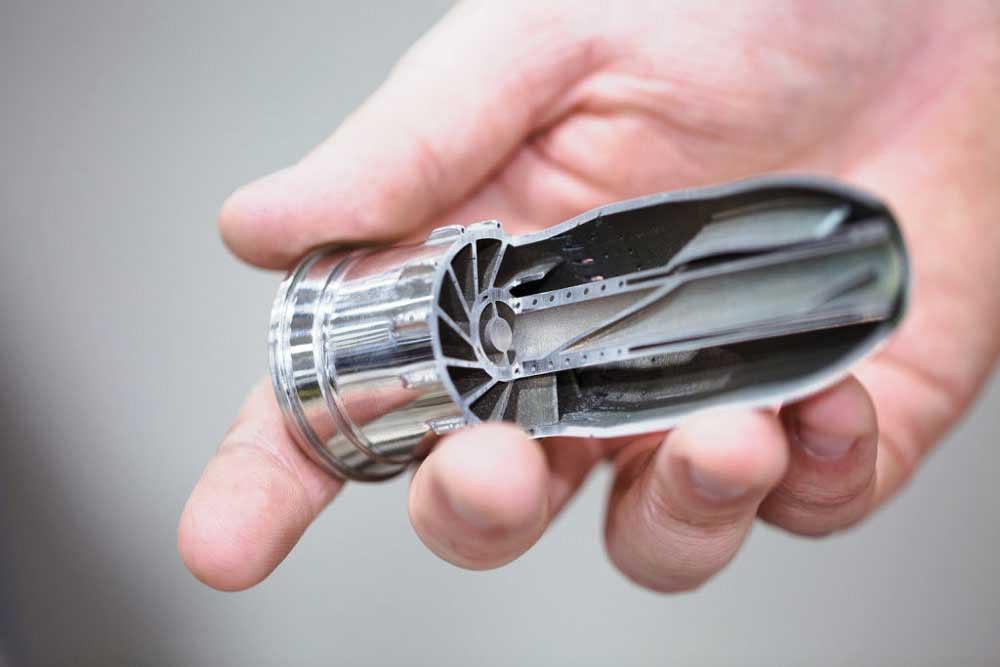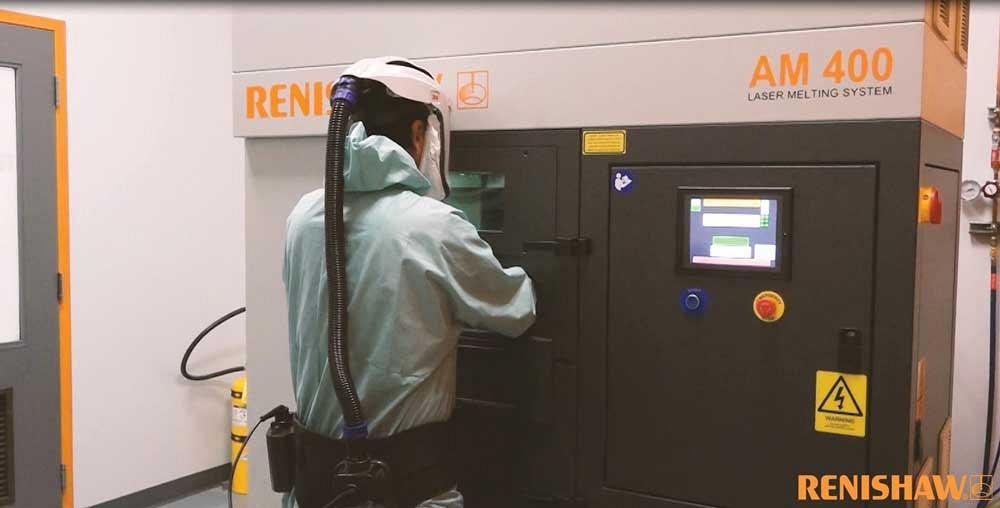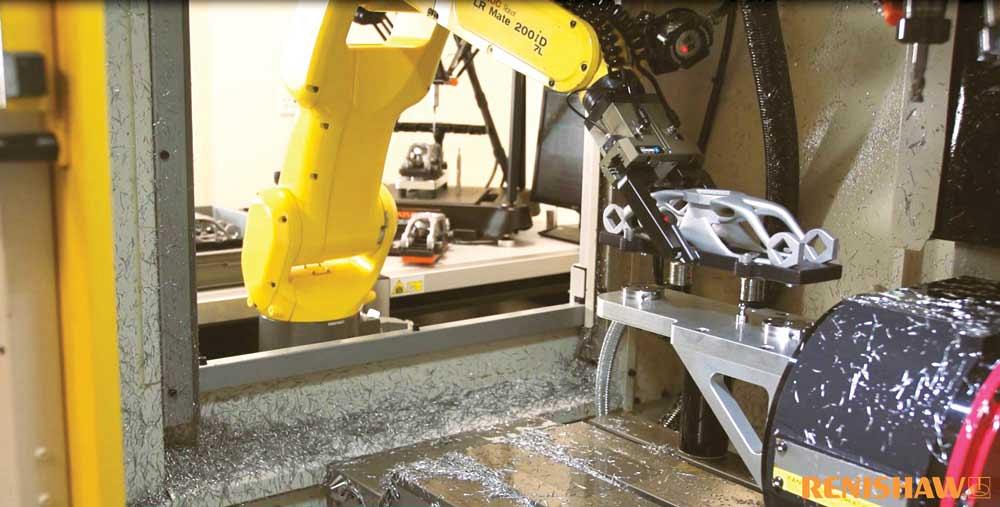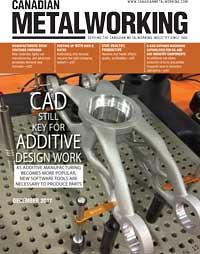- FMA
- The Fabricator
- FABTECH
- Canadian Metalworking
CAD still key for additive design work
As additive manufacturing becomes more popular, new software tools are necessary to produce parts
- By Nate Hendley
- January 5, 2018
- Article
- Automation and Software

In the aerospace industry, AM has moved beyond the introductory phase and into mainstream manufacturing thanks to its ability to create strong, lightweight parts. Photo courtesy of GE.
Last year GE Aviation -- a subsidiary of General Electric -- started using additive manufacturing (AM) technology to mass-produce fuel nozzle injectors. The injectors are for LEAP® jet engines from CFM Intl. (a company run jointly by GE and Safran Aircraft Engines).
According to GE, this initiative marks the first time a sophisticated component for jet engines was manufactured in such a fashion. By the end of this decade, GE Aviation hopes to be using roughly 50 AM machines at its Auburn, Ala., facility to make more than 35,000 jet engine fuel nozzle injectors per year.
AM got a further boost from GE when the company opened the Center for Additive Technology Advancement (CATA) in April 2016. Located in Pittsburgh, the center is 125,000 sq. ft. and employs 50 people.
“Our core mission for the last couple years has been to help GE businesses and GE additive customers industrialize additive manufacturing,” said Kirk Rogers, technology leader at the center.
Canada hasn’t been a slouch in AM, either. In November 2016 Renishaw Canada launched the Additive Manufacturing Solutions Centre in Kitchener, Ont., which researches and develops metal AM projects.
The presence of these two new centres devoted to AM technology, combined with GE Aviation’s pioneering production efforts, underlines an obvious fact: Additive manufacturing has moved beyond the novelty stage and is edging toward mainstream manufacturing.
AM: How It’s Done
In traditional, subtractive manufacturing, parts are created by cutting away at a solid mass of material. During AM, special equipment produces layered, 3-D metal, plastic, and ceramic parts, based on digital designs. Parts are produced directly from CAD software files, eliminating the need for traditionally produced tooling in the production process.
Unlike conventional manufacturing, in which small pieces are joined through a welding or brazing process, additive parts can be produced as a single structure. Because these parts don’t require assembly, brazing, or welding, they are generally stronger and have better durability than their conventionally manufactured counterparts.
“Whenever you assemble something as a series of components, there’s a probability that the interface will fail. Mathematically, when you put enough pieces together, those probabilities start to accumulate, and your part is fundamentally less reliable. If [additive] is done well, it should be possible to achieve a more durable, reliable component. The GE fuel injector is a very good example of that,” explained Mark Kirby, additive manufacturing business manager, Renishaw Canada.
AM: The Industries
GE Aviation made its fuel nozzle injectors as a single structure.

In November 2016 Renishaw Canada launched the Additive Manufacturing Solutions Centre in Kitchener, Ont., which researches and develops metal AM projects. Photo courtesy of Renishaw Canada
Using traditional casting processes would have entailed brazing and welding 20 different pieces together. GE estimates that its fuel nozzle injector is one-quarter lighter and five times more durable than a similar product made via subtractive methods. While parts made with a subtractive manufacturing process are solid, additive parts can be hollow, so they weigh less.
Such attributes have made AM popular in aerospace circles, where designers are constantly looking to reduce weight. At the same time, it’s vital for flying aircraft to have parts that are strong, durable, and reliable.
The medical device/implant and power generation sectors also have been quick to embrace additive technology.
The automotive market also has expressed interest in the theory. AM, however, is slow and expensive compared to subtractive methods, making it a poor fit -- at the moment -- for extremely high-volume production.
AM: Design Keys
Because additive parts are made as one entire structure, engineers enjoy considerably greater design freedom than in traditional manufacturing. The additive process lends itself to “design complexity,” as Rogers puts it.
“Think about products with complicated internal geometries, [such as] fluid flow channels in a bracket. Today you would make a bracket that’s a structural part and maybe that bracket then has something bolted on it that holds the tube in place,” said Rogers.
By contrast, made with AM, a bracket can be designed and manufactured with flow channels and a tube holder already built in.
There’s also less waste material involved in additive applications than in subtractive.
For now, however, most parts made with additive technology still require a dash of traditional machining. Typically, some machining is necessary to finish additive parts.
“The difference is, you’re not doing bulk material removal. You’re just doing a finishing pass,” said Rogers.

GE Aviation started using AM technology to mass-produce fuel nozzle injectors for its LEAP jet engine program. Photo courtesy of GE.
Parts intended for additive applications can be designed on current CAD software programs.
“From the CAD perspective, we use traditional tools, like Creo, NX, or SolidWorks. Where you need special tools is when you actually take your 3-D design and get it on the printer,” said Rogers.
At this point, special software is needed to guide the additive printing process. Rogers compared this step to using CAM software during CNC machining.
“We use ‘slicing software,’” explained Rogers. “It takes a 3-D file and ‘slices’ things into planes, so that a printer understands how to develop a path to make the geometry.”
Plenty of new tools are available for designing and making parts via AM.
New AM Equipment
“We’re introducing a four-laser machine that’s going to be three to four times faster than previous systems,” Kirby said.
The laser in question is the RenAM 500Q four-laser AM system. Renishaw claims the system will reduce part cost, enhance quality, and, perhaps most important dramatically speed up the metal additive process.
Tech Soft 3D of Bend, Ore., is a provider of software development tools with a focus on 3-D printing applications.
“Our role in this space is that we provide the nuts and bolts that both CAD companies and additive manufacturing companies will then use in their software,” explained Jonathan Girroir, technical marketing manager at Tech Soft 3D. “We [also have] partnered with Siemens. They have this Convergent Modeling functionality that merges all your additive tools with all of your traditional solid-modelling tools.”
In fall 2017 Siemens released the latest version of Simcenter 3D, its flagship software program for computer-aided engineering (CAE). The software utilizes Convergent Modeling technology, which optimizes part design for 3-D printing. Among other features, the software allows engineers to work directly with data that has been scanned to speed the design process, and it offers generative design work flows.

The 3-D printed nozzle combined 20 parts into a single unit, but it also weighed 25 per cent less. Photo courtesy of GE.
Generative design refers to a process in which engineers input data into a computer then let it mull the information over to present a set of design options for the part in question. Cloud computing plays a big role in this process.
“Generative design is something that’s much more practical in additive than subtractive,” said Girroir.
“The design software folks are working hard on generative design. [With traditional methods] you could make a really complicated design, but it would be very tough to manufacture. With an additive set of tools, you can manufacture very complicated designs,” added Rogers.
AM: The Future
Researchers at CATA also are looking closely at other intriguing applications with futuristic implications.
“If you think of wood, it has a grain. All metals have a grain structure, too, and that sometimes determines their mechanical properties. Instead of just inheriting that structure during a manufacturing process like casting, where you can’t control it, in additive we’re on the cusp of being able to control the grain structure. [You could] change the properties in a part. So a part that needs to be superstrong, you can probably make it stronger, and a place where it needs to be superductile or resistant to vibration, you can make it like that in the same component,” said Rogers.
Exciting stuff, but don’t expect such techniques to become commonplace in machine shops any time soon.
While AM is making gains, using the technology still involves a fair degree of commitment and cost.
“This is still a small market. The raw materials are fairly expensive, and the process is fairly expensive. The other barrier is the speed of the process. I think if I had to put a number on it, additive is going to grow in the next decade to about 1 per cent of total manufacturing output. There will be some critical application markets in manufacturing that will completely shift from conventional ways of doing things to additive ways of doing things. We’ll be a significant subset of manufactured goods,” said Rogers.
Contributing writer Nate Hendley can be reached at nhendley@sympatico.ca.
GE Center for Additive Technology Advancement, 502-452-4311, www.ge.com/additive

Parts are “built” from CAD files, but the rest of the production process, including automation, remains the same. Photo courtesy of Renishaw Canada.
Renishaw Canada Additive Manufacturing Solutions Centre, 905-828-0104, www.renishaw.com
Tech Soft 3D, 541-383-4126, www.techsoft3d.com
About the Author
subscribe now


Keep up to date with the latest news, events, and technology for all things metal from our pair of monthly magazines written specifically for Canadian manufacturers!
Start Your Free Subscription- Industry Events
MME Winnipeg
- April 30, 2024
- Winnipeg, ON Canada
CTMA Economic Uncertainty: Helping You Navigate Windsor Seminar
- April 30, 2024
- Windsor, ON Canada
CTMA Economic Uncertainty: Helping You Navigate Kitchener Seminar
- May 2, 2024
- Kitchener, ON Canada
Automate 2024
- May 6 - 9, 2024
- Chicago, IL
ANCA Open House
- May 7 - 8, 2024
- Wixom, MI




















